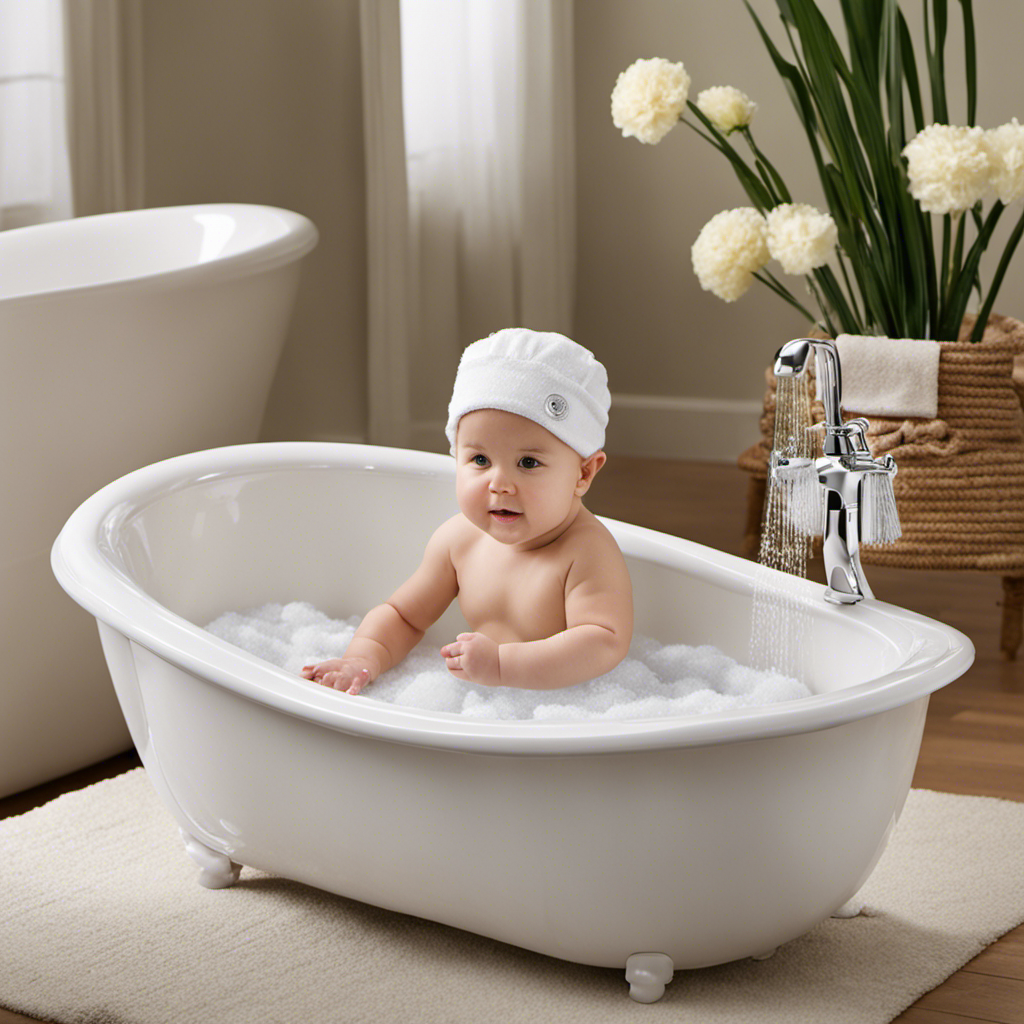Tired of staring at those stubborn bathtub stains? Wondering how to get rid of them once and for all? Well, you’re in luck!
In this article, we’ll show you the step-by-step process to banish those pesky stains and bring back the sparkle to your bathtub.
From understanding the different types of stains to effective DIY removal methods, we’ve got you covered.
So, grab your cleaning supplies and get ready to say goodbye to bathtub stains for good!
Key Takeaways
- Prepare your bathtub by gathering necessary cleaning supplies and wearing protective gear.
- Use DIY stain removal methods such as vinegar and baking soda, lemon juice, or hydrogen peroxide.
- Consider the effectiveness and safety precautions of commercial stain removers, but also explore natural remedies like vinegar, baking soda, and lemon juice.
- Take safety precautions when dealing with stains, regularly clean to prevent buildup, avoid abrasive tools and chemicals, and consider professional refinishing for extensive stains or damage.
Types of Bathtub Stains
There are three main types of bathtub stains that can be difficult to remove.
The first type is rust stains, which are caused by water containing iron or other minerals coming into contact with metal surfaces in the bathtub. These stains can be stubborn and leave an unsightly orange or reddish-brown mark.
The second type is hard water stains, which occur when water with high mineral content evaporates, leaving behind a residue of calcium and magnesium. These stains can appear as white or grayish spots and can be especially challenging to remove.
To effectively tackle rust and hard water stains, it’s important to use the right cleaning products and techniques.
Understanding the Causes of Bathtub Stains
Understanding the causes of bathtub stains can help prevent them from occurring in the future. There are several common stain triggers that can lead to discoloration in your bathtub.
One of the main causes is hard water, which contains minerals that can leave behind a residue.
Soap scum is another culprit, forming when soap combines with minerals in the water.
Rust stains can occur when the metal in your bathtub or pipes begins to corrode.
Mold and mildew thrive in damp environments, leading to unsightly stains.
Additionally, certain cleaning products, like bleach or harsh chemicals, can cause discoloration if not used properly.
Preparing Your Bathtub for Stain Removal
To prepare your bathtub for stain removal, start by gathering the necessary cleaning supplies. Here’s what you’ll need:
-
Cleaning Supplies:
-
Rubber gloves to protect your hands from harsh chemicals.
-
Safety goggles to shield your eyes from splashes.
-
Alternative Cleaning Methods:
-
Baking soda: a natural and effective cleaner for mild stains.
-
Vinegar: a versatile solution that helps remove tough stains.
-
Lemon juice: a natural acid that can dissolve mineral deposits.
Before you begin, make sure to take protective measures by wearing rubber gloves and safety goggles to ensure your safety.
Now that you have your supplies ready, you can move on to the next step: effective DIY stain removal methods.
Transition: Now that your bathtub is prepped for cleaning, let’s explore some effective DIY stain removal methods.
Effective DIY Stain Removal Methods
When it comes to DIY stain removal, you have a few effective options to choose from.
Two popular choices are vinegar and baking soda. Vinegar is a versatile cleaner that can be used on a variety of surfaces, while baking soda is known for its abrasive properties that help lift stains.
Another option to consider is lemon juice, which not only acts as a natural cleaner but also leaves a fresh citrus scent behind.
Vinegar Vs. Baking Soda
You can choose between vinegar and baking soda to tackle those bathtub stains. Both options have their own benefits and alternatives that can help you effectively remove stains. Here’s what you need to know:
-
Vinegar Benefits:
-
Natural and non-toxic: Vinegar is a safe and eco-friendly option for stain removal.
-
Effective against various stains: Whether it’s soap scum, mineral deposits, or grime, vinegar can help break down and dissolve these stains.
-
Baking Soda Alternatives:
-
Lemon juice: The acidic properties of lemon juice can work similarly to vinegar and help remove stains.
-
Hydrogen peroxide: This powerful stain remover can be used as an alternative to baking soda for tougher stains.
Both vinegar and baking soda are versatile and affordable options for removing bathtub stains. Choose the one that suits your preferences and get ready to enjoy a sparkling clean bathtub.
Lemon Juice as Cleaner
Lemon juice, with its acidic properties, can be a great alternative to vinegar for removing various stains. When it comes to cleaning your bathtub, using natural alternatives like lemon juice can be both effective and safe.
The benefits of lemon juice as a cleaner are numerous. First, it is a natural disinfectant, killing bacteria and germs that may be lurking in your bathtub. Second, lemon juice has strong stain-removing properties that can break down and dissolve stubborn stains, such as soap scum or hard water deposits.
Additionally, lemon juice leaves behind a fresh and citrusy scent, making your bathroom smell clean and inviting. To use lemon juice as a cleaner, simply squeeze the juice onto a sponge or cloth and scrub the stained areas. Rinse thoroughly with water and enjoy a sparkling clean bathtub.
Using Commercial Stain Removers for Bathtubs
When it comes to using commercial stain removers for your bathtub, it’s important to consider the effectiveness of different brands. Some brands may be more efficient in removing tough stains, while others may fall short.
Additionally, it is crucial to take safety precautions while using these products, such as wearing gloves and ensuring proper ventilation in the bathroom.
Lastly, it’s wise to compare the cost of different products to find the best value for your money without compromising on quality.
Effectiveness of Different Brands
To see which brand works best, try using different stain removers on your bathtub. Here are some options to consider:
-
Commercial stain removers:
-
Pros:
-
Many commercial stain removers are specifically formulated to tackle tough bathtub stains.
-
They often contain strong chemicals that can effectively break down and remove stubborn stains.
-
Cons:
-
Some commercial stain removers can be harsh on your skin and respiratory system, so be sure to use them in a well-ventilated area and wear protective gloves.
-
They may contain synthetic ingredients that can be harmful to the environment.
-
Natural remedies:
-
Pros:
-
Natural remedies such as baking soda, vinegar, and lemon juice can be effective in removing mild stains.
-
They are generally safer for your health and the environment compared to commercial stain removers.
-
Cons:
-
Natural remedies may not be as potent as commercial stain removers, so they may not work on deep or stubborn stains.
-
They may require more time and effort to achieve desired results.
Remember to always follow the instructions on the product labels or the recommended usage for natural remedies.
Safety Precautions to Take
Make sure you always wear protective gloves and use stain removers in a well-ventilated area to ensure your safety.
When dealing with stubborn bathtub stains, it is important to prioritize your well-being. Before starting the cleaning process, gather the necessary safety equipment, such as gloves and goggles, to protect your skin and eyes from harmful chemicals. Stain removers often contain strong chemicals that can be hazardous if not handled with care.
Additionally, it is crucial to work in a well-ventilated area to prevent inhaling any fumes. Open windows and turn on fans to promote proper ventilation. If possible, consider wearing a mask to further protect yourself.
Cost Comparison of Products
Comparing the cost of different products can help you find the most affordable option for removing stubborn stains from your bathtub. Conducting a cost analysis is crucial to ensure you make an informed decision.
Here are two key factors to consider when comparing the cost of different stain removal products:
-
Initial cost:
-
Look for products that offer value for money. Consider the price per unit or the overall cost of the product.
-
Take note of any additional tools or equipment required for application, as these can add to the overall cost.
-
Long-term effectiveness:
-
Research customer reviews and ratings to gauge the effectiveness of the product over time.
-
Consider the durability of the product and its ability to prevent future stains, as this can save you money in the long run.
Preventing Future Bathtub Stains
You can easily prevent future bathtub stains by regularly cleaning your bathtub using a mild cleanser. Taking proactive steps to prevent stains can save you time and effort in the long run.
One effective method is to create a cleaning routine where you clean your bathtub at least once a week. This helps to remove any dirt, grime, or soap scum that can lead to stains.
Additionally, using a bathtub mat or non-slip stickers can prevent scratches and stains caused by items like razors or bottles.
Another long-term stain prevention measure is to avoid using abrasive cleaning tools or harsh chemicals that can damage the surface of your bathtub.
Frequently Asked Questions
Can I Use Bleach to Remove Bathtub Stains?
You can use bleach as a powerful bathtub stain remover, but there are also alternatives like vinegar and baking soda. These natural options can work just as effectively and are safer for you and the environment.
What Are Some Natural Remedies for Removing Bathtub Stains?
To remove bathtub stains, try using vinegar or baking soda. Vinegar can be mixed with water and sprayed onto the stains, while baking soda can be made into a paste and scrubbed onto the stains.
Are There Any Specific Cleaning Products I Should Avoid Using on My Bathtub?
To avoid damaging your bathtub, steer clear of harsh cleaning products. Opt for alternative cleaning methods like baking soda and vinegar. And remember, prevention is key – regularly clean your tub and avoid leaving products or chemicals sitting for too long.
Is It Safe to Use Abrasive Scrubbing Pads on Bathtub Stains?
Using abrasive scrubbing pads on bathtub stains can be effective but may scratch the surface. Consider alternative methods like using baking soda, vinegar, or hydrogen peroxide. These solutions are gentler and can still remove stains effectively.
How Often Should I Clean My Bathtub to Prevent Stains From Forming?
To prevent bathtub stains, you should clean your tub regularly. Regular cleaning helps to prevent buildup and stains from forming. Non-toxic cleaners are a great option for removing stains without causing harm.
Conclusion
Congratulations! You’ve now learned how to get rid of those pesky bathtub stains. By understanding the causes of the stains and preparing your bathtub properly, you can effectively remove them using DIY methods or commercial stain removers.
And the best part? You can prevent future stains by maintaining a regular cleaning routine.
So go ahead, enjoy a sparkling clean bathtub and impress your guests with a bathroom that looks like it belongs in a fancy magazine.
Happy scrubbing!










